|
3. Pressure measurements These measurements help to provide a partial solution to the problems of engine cooling and passenger cabin air-conditioning. Pressures are expressed as a non-dimensional coefficient independent of speed: Cp = P-Po Bernouilli's equation : 1/2 pV2 + P = Constant along an air fillet is valid as a first approximation for the front of the vehicle. It proves that high-pressure areas have low air speed. Conversely, where the air fillets cling to the body, there is a depression. (The drawing will help you to understand this relation between air speeds and pressures at any point). |
|||||||||||||||||||||||||||||||||||||||||||||
|
Pressure measurements make it possible to trace isobars (lines perpendicular to the air fillets visualising the lines along which pressure remains equal at a given value) on the vehicle's form. The choice of the position of the air inlet for passenger-cabin air-conditioning will lie in the pressure zone at the foot of the windscreen. |
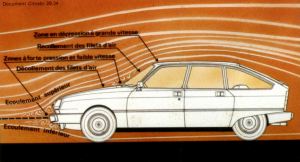 |
||||||||||||||||||||||||||||||||||||||||||||
| Air-fillet flow over a Citoën GSA | |||||||||||||||||||||||||||||||||||||||||||||
|
AN AIR OF ECONOMY The power that the engine must develop in order to overcome different forms of resistance (apart from accelerations and gravity) is represented by the formula: W wheels = N. Wm = 1/2QCxSV3 +f. M.V. where:
The two following graphs represent respectively the formulae above, applied to a current standard production car, and the car's consumption in litres per 100 km according to speed. We can note the importance of streamlining for speeds approaching and over 90 km/h /56 mph), and the similarity between resistance and consumption curves, demonstrating the important role played by aerodynamics in fuel saving. |
|||||||||||||||||||||||||||||||||||||||||||||
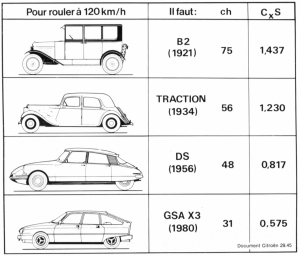 |
To travel at 120 kph (75 mph)
|
||||||||||||||||||||||||||||||||||||||||||||
|
When a car's CxS is improved by 10 %, consumption at 120 km/h (74.6 mph) goes down by 7 %, at 90 km/h (56 mph) by 5 %, in town traffic by 1 %. The characteristics of motor cars' resistance to motion can be improved by entirely redesigning their bodywork. The bodies of current 4-door saloons have Cxs coefficients lying between 0.575m2 (6.19 sq.ft) for the best and 0.900 m2 (9.69 sq.ft) for the least good, or CxS of between 0.32 and 0.48. The improvement of known aerodynamic forms can also be achieved by fitting corrective adjuncts. |
|||||||||||||||||||||||||||||||||||||||||||||
|
The drag of the Citroën GSA X3 has been reduced by the addition of a forward spoiler (which acts as a deflector and reduces the air-flow under the body) and of an aerofoil beneath the rear window (which reduces drag by modifying the rear lift characteristics), and by fitting a better streamlined rear-view mirror. The spoiler improves the CxS by 2.7 %, the aerofoil by 7.5 %. Both together improve the CxS by 10 % and reduce petrol consumption by 7.5 % at 120 km/h (74.6 mph). |
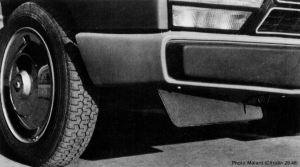 |
||||||||||||||||||||||||||||||||||||||||||||
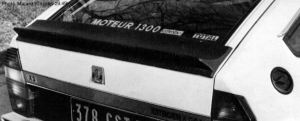 |
And yet, if in the future every manufacturer is to be faced with achieving the best aerodynamic shapes, the results of these studies will always remain subordinate to sociological and legal possibilities (impossibility of producing extremely long, low cars, for instance), just as it will remain combined with the stylist's own trends. |
||||||||||||||||||||||||||||||||||||||||||||
|
In this respect, let us point out the misconception of which stylists, manufacturers, journalists and public alike are guilty about items such as spoilers and aerofoils, considered by one and all as optional extras for a sports car, whereas in fact, when, properly designed, they are first and foremost energy economisers which could easily and cheaply by provided for in standard production models. Knowing that the shape of the body weighs heavily in the decision to buy a car, it is the stylists, at Citroën's, who combine the results of body studies with respect of the various restrictions they must comply with:
The aerodynamicist, for his part, has to check the results found with the first few shapes made up, and to suggest possible improvements to the stylist. The entire effectiveness of their collaboration takes form in their definition of an ambitious aerodynamic performance project and in their aptitude to achieve it in a seductive form. This mode of collaboration between stylist and technician has been and remains characteristic of the genesis of Citroën models. Long before the energy crisis was upon us, and by mere logic and a desire for a coherent approach to car-body design, Citroën models had already achieved exemplary CxS values recognised by specialists the world over. These studies undertaken years ago now ensure for Citroën a far from negligible advance where the influence of "the right shape" on reducing fuel consumption is concerned. |
|||||||||||||||||||||||||||||||||||||||||||||
|
Below - one of the first -styling sketches for the CX |
Aerodynamic co-efficient values for various Citroëns in standard road-going configuration
|
||||||||||||||||||||||||||||||||||||||||||||
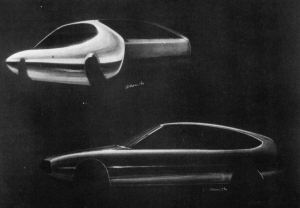 |
|||||||||||||||||||||||||||||||||||||||||||||
This article originally appeared in Double Chevron #59 © Automobiles Citroën 1980
|
|||||||||||||||||||||||||||||||||||||||||||||
- Oct 29 Mon 2007 21:42
AERODYNAMICS #2
全站熱搜
 留言列表
留言列表
發表留言


 留言列表
留言列表